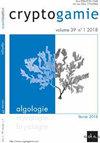标题亚洲刺蕨新种(刺蕨科,硅藻门)及其生物地理研究述评
IF 1.5
4区 生物学
Q3 MARINE & FRESHWATER BIOLOGY
引用次数: 8
摘要
本文报道了亚洲四种汉纳属新种的光镜和扫描电镜观察结果。亚洲的新分类群包括西藏、蒙古和西亚的帕米尔山区。该属的两个亚群均有代表,包括H. tibetiana Q. Liu, Glushchenko, Kulikovskiy & Kociolek, sp. nov.和H. pamirensis Glushchenko, Kulikovskiy, Q. Liu & Kociolek, sp. nov.,来自包含属型的群,其条纹由单列的茧孔组成,每个瓣有一个裂口。Glushchenko, Kulikovskiy, Q. Liu & Kociolek, sp. 11 .和H. mongolica Glushchenko, Kulikovskiy, Q. Liu & Kociolek, sp. 11 .的条纹由两排乳晕和两排乳晕组成;阀门两端各有一个。每瓣有两个棱孔和双棱纹的群体只在贝加尔湖、Khovsgol湖和亚洲周边地区已知。另外四个物种提出了新的组合。这些分类群也来自亚洲。其中两个来自日本,一个来自中国,一个来自俄罗斯的贝加尔湖。亚洲似乎是汉尼亚的一个重要的多样性中心。本文章由计算机程序翻译,如有差异,请以英文原文为准。
New Hannaea Patrick (Fragilariaceae, Bacillariophyta) Species from Asia, with Comments on the Biogeography of the Genus
Light and scanning electron microscope observations are provided on four new Hannaea Patrick species from Asia. The areas in Asia the new taxa are described from include Tibet, Mongolia and the Pamir mountainous region in western Asia. Both subgroups of the genus are represented, including H. tibetiana Q. Liu, Glushchenko, Kulikovskiy & Kociolek, sp. nov. and H. pamirensis Glushchenko, Kulikovskiy, Q. Liu & Kociolek, sp. nov., from the group that includes the generitype and has striae composed of single rows of areolae and one rimoportula per valve. Hannaea dorofeyukae Kulikovskiy, Glushchenko, Q. Liu & Kociolek, sp. nov. and H. mongolica Glushchenko, Kulikovskiy, Q. Liu & Kociolek, sp. nov. have striae composed of two rows of areolae and two rimoportulae; one at each end of the valve. The group with two rimoportulae per valve and biseriate striae is known only from Lakes Baikal, Khovsgol and the surrounding areas in Asia. New combinations are proposed for four other species. These taxa are also known from Asia. Two of them are known from Japan, one is from China and one is from Lake Baikal in Russia. It appears that Asia is an important center of diversity for Hannaea.
求助全文
通过发布文献求助,成功后即可免费获取论文全文。
去求助
来源期刊

Cryptogamie Algologie
生物-海洋与淡水生物学
CiteScore
2.60
自引率
7.70%
发文量
11
审稿时长
>12 weeks
期刊介绍:
Cryptogamie is a fast-track and peer-reviewed journal of international scope publishing in English only. It accepts original papers and review articles on the taxonomy, biology and ecology of all cryptogams. An issue of Cryptogamie may be devoted to a single topic, under the responsibility of guest editor(s). All articles published in Cryptogamie are compliant with the different nomenclatural codes. A copyright assignment will be signed by the authors before publication.
Cryptogamie, Algologie accepts articles on systematics as well as ecology and evolution of any kind of algae (including Cyanobacteria).
 求助内容:
求助内容: 应助结果提醒方式:
应助结果提醒方式:


